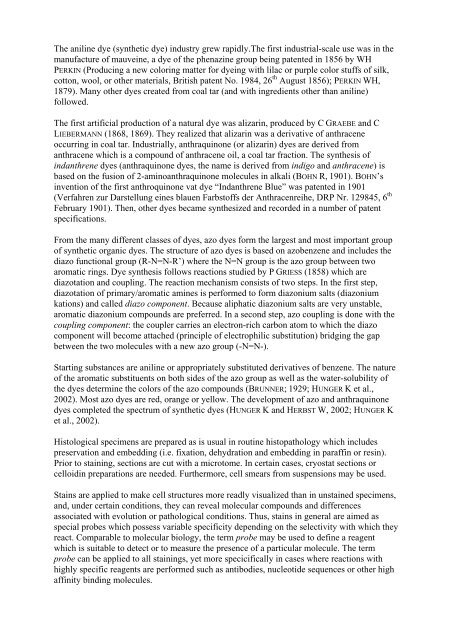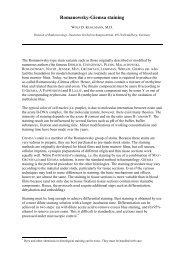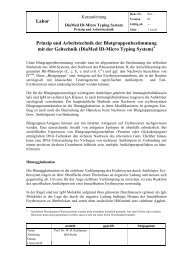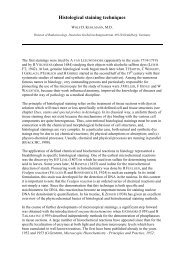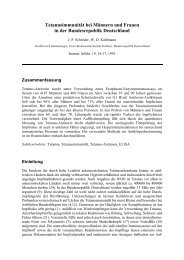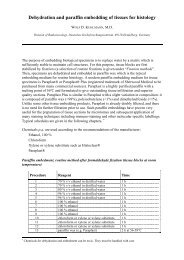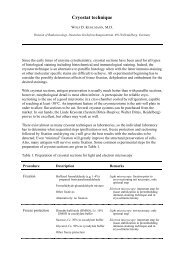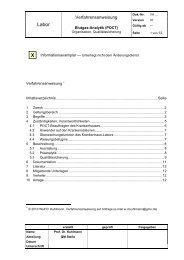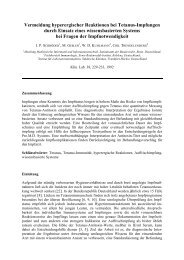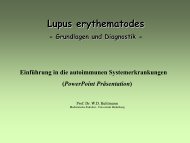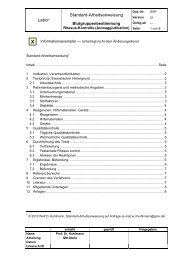Dyes, stains, and special probes in histology
Dyes, stains, and special probes in histology
Dyes, stains, and special probes in histology
You also want an ePaper? Increase the reach of your titles
YUMPU automatically turns print PDFs into web optimized ePapers that Google loves.
The anil<strong>in</strong>e dye (synthetic dye) <strong>in</strong>dustry grew rapidly.The first <strong>in</strong>dustrial-scale use was <strong>in</strong> themanufacture of mauve<strong>in</strong>e, a dye of the phenaz<strong>in</strong>e group be<strong>in</strong>g patented <strong>in</strong> 1856 by WHPERKIN (Produc<strong>in</strong>g a new color<strong>in</strong>g matter for dye<strong>in</strong>g with lilac or purple color stuffs of silk,cotton, wool, or other materials, British patent No. 1984, 26 th August 1856); PERKIN WH,1879). Many other dyes created from coal tar (<strong>and</strong> with <strong>in</strong>gredients other than anil<strong>in</strong>e)followed.The first artificial production of a natural dye was alizar<strong>in</strong>, produced by C GRAEBE <strong>and</strong> CLIEBERMANN (1868, 1869). They realized that alizar<strong>in</strong> was a derivative of anthraceneoccurr<strong>in</strong>g <strong>in</strong> coal tar. Industrially, anthraqu<strong>in</strong>one (or alizar<strong>in</strong>) dyes are derived fromanthracene which is a compound of anthracene oil, a coal tar fraction. The synthesis of<strong>in</strong>danthrene dyes (anthraqu<strong>in</strong>one dyes, the name is derived from <strong>in</strong>digo <strong>and</strong> anthracene) isbased on the fusion of 2-am<strong>in</strong>oanthraqu<strong>in</strong>one molecules <strong>in</strong> alkali (BOHN R, 1901). BOHN’s<strong>in</strong>vention of the first anthroqu<strong>in</strong>one vat dye “Indanthrene Blue” was patented <strong>in</strong> 1901(Verfahren zur Darstellung e<strong>in</strong>es blauen Farbstoffs der Anthracenreihe, DRP Nr. 129845, 6 thFebruary 1901). Then, other dyes became synthesized <strong>and</strong> recorded <strong>in</strong> a number of patentspecifications.From the many different classes of dyes, azo dyes form the largest <strong>and</strong> most important groupof synthetic organic dyes. The structure of azo dyes is based on azobenzene <strong>and</strong> <strong>in</strong>cludes thediazo functional group (R-N=N-R’) where the N=N group is the azo group between twoaromatic r<strong>in</strong>gs. Dye synthesis follows reactions studied by P GRIESS (1858) which arediazotation <strong>and</strong> coupl<strong>in</strong>g. The reaction mechanism consists of two steps. In the first step,diazotation of primary/aromatic am<strong>in</strong>es is performed to form diazonium salts (diazoniumkations) <strong>and</strong> called diazo component. Because aliphatic diazonium salts are very unstable,aromatic diazonium compounds are preferred. In a second step, azo coupl<strong>in</strong>g is done with thecoupl<strong>in</strong>g component: the coupler carries an electron-rich carbon atom to which the diazocomponent will become attached (pr<strong>in</strong>ciple of electrophilic substitution) bridg<strong>in</strong>g the gapbetween the two molecules with a new azo group (-N=N-).Start<strong>in</strong>g substances are anil<strong>in</strong>e or appropriately substituted derivatives of benzene. The natureof the aromatic substituents on both sides of the azo group as well as the water-solubility ofthe dyes determ<strong>in</strong>e the colors of the azo compounds (BRUNNER; 1929; HUNGER K et al.,2002). Most azo dyes are red, orange or yellow. The development of azo <strong>and</strong> anthraqu<strong>in</strong>onedyes completed the spectrum of synthetic dyes (HUNGER K <strong>and</strong> HERBST W, 2002; HUNGER Ket al., 2002).Histological specimens are prepared as is usual <strong>in</strong> rout<strong>in</strong>e histopathology which <strong>in</strong>cludespreservation <strong>and</strong> embedd<strong>in</strong>g (i.e. fixation, dehydration <strong>and</strong> embedd<strong>in</strong>g <strong>in</strong> paraff<strong>in</strong> or res<strong>in</strong>).Prior to sta<strong>in</strong><strong>in</strong>g, sections are cut with a microtome. In certa<strong>in</strong> cases, cryostat sections orcelloid<strong>in</strong> preparations are needed. Furthermore, cell smears from suspensions may be used.Sta<strong>in</strong>s are applied to make cell structures more readly visualized than <strong>in</strong> unsta<strong>in</strong>ed specimens,<strong>and</strong>, under certa<strong>in</strong> conditions, they can reveal molecular compounds <strong>and</strong> differencesassociated with evolution or pathological conditions. Thus, <strong>sta<strong>in</strong>s</strong> <strong>in</strong> general are aimed as<strong>special</strong> <strong>probes</strong> which possess variable specificity depend<strong>in</strong>g on the selectivity with which theyreact. Comparable to molecular biology, the term probe may be used to def<strong>in</strong>e a reagentwhich is suitable to detect or to measure the presence of a particular molecule. The termprobe can be applied to all sta<strong>in</strong><strong>in</strong>gs, yet more specicifically <strong>in</strong> cases where reactions withhighly specific reagents are performed such as antibodies, nucleotide sequences or other highaff<strong>in</strong>ity b<strong>in</strong>d<strong>in</strong>g molecules.


